On a foggy Monday morning in May 2016, 14 Amsterdam officials, engineers and civil servants gathered nervously at Alexanderplein – a busy intersection near the city centre with three tramlines – where many people were walking, driving, and, as in any Dutch city, riding bicycles. With a flip of a switch, the traffic controls were shut off for all transport modes, in all directions.
This live pilot project came about as a result of the rapid growth in cycling in some Amsterdam neighbourhoods. Nearly 70% of all city centre trips are by bicycle, and more space is needed on the bike networks. Traffic designers are deviating from standard design manuals to accommodate this need. Among the tactics being used are the removal of protective barriers, altering light phases, reducing vehicular speed limits and designating entire corridors as “bicycle streets”. Designers have created their own toolbox of solutions for other Dutch cities to use.
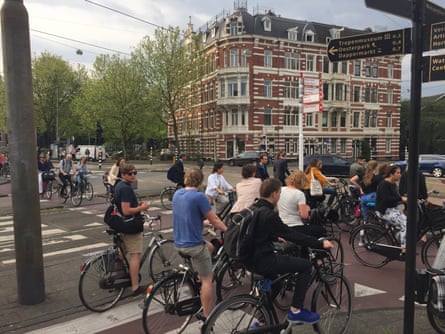
But switching off traffic lights for all modes on a busy intersection for days on end steps up a level of disruption. Even in Amsterdam, the pilot sparked debate among engineers and politicians.
“It took eight months to plan this intervention,” says Amsterdam’s former bicycle program manager, Iris van der Horst. “We had to get all the stakeholders on board, including the police and public transit authority. Everyone was nervous and wanted to be sure safety was not compromised.”
The pilot is part of a larger mobility strategy across the city to make more room for cyclists and pedestrians. That means limiting access and space for private vehicles.
“Amsterdam’s public space is limited,” says the vice mayor for traffic, Pieter Litjens, who ultimately approved the pilot. “We need to be thoughtful and strategic about who and what uses that space.”
The city measured the impact of the intervention through a technical study, evaluating safety, conflict, and traffic flow. In additional, the Urban Cycling Institute studied the impact on human behaviour, perceptions, and experiences.
In the weeks before the lights were shut off, we intercepted about 200 cyclists on their morning and evening commutes. A majority of them disliked the intersection and made complaints: “it’s chaotic”; “messy”; “no one obeys the lights”; “the lights are all green at the same time”.

When asked whether the traffic lights were necessary, about a third said “absolutely yes”, only 5% said “absolutely not”, and the majority was undecided. It was clearly a question they had never thought about.
In the behavioural analysis, cyclists at the stop line glared at the signal, almost willing it to turn green. Bodies were focused forward; heads and eyes motionless; posture slouched. Most cyclists appeared expressionless. Stopping at this light seemed to be a moment to zone out, check their phone, adjust their bell or pedals. Very little interaction took place, either among cyclists or between other transport modes, for example with car drivers.
When the lights were turned off, about 150 cyclists were interviewed. We found that not only did fewer people dislike this intersection, but about 60% said the traffic situation had improved.
All respondents complained less about infrastructure and spoke more about human interaction. “People pay more attention,” said one man. “It’s amazing that it regulates itself,” said a young woman. “It’s a bit scary, but you never have to stop and nobody is grumpy,” said a teenager. But no one could really explain more about why or how.
Behaviour was noticeably different. Most cyclists slowed down as they approached the intersection, and communicated to other cyclists and motorists using eyes, gestures, expressions, and voices. A lot more negotiation was taking place – but not without friction. In one incident, a mother carrying her child on a front seat slowly entered the intersection. When she was halfway across, a car approached from the right. Traffic signs indicate priority for the car driver but instead, the mother made eye contact with the driver, both smiled, and the car driver yielded.

The new setup forced people to engage with their surroundings. They had to change the behavioural rituals they had fallen into in order to adapt. Instead of relying on traffic lights, they now relied on their own abilities and the cues of others. This adaptation takes time and is a complex cognitive process: brain neurons work overtime, senses are heightened and multiple levels of information have to be unravelled.
Once new rituals are formed, instantaneous decisions are made unconsciously again, using the body’s movement to power and guide a machine. This tacit process occurs so fast it is difficult to explain in words – again, confirmed in our interviews.
Such interaction and “negotiation in motion” may sound stressful, as some respondents noted, but what kind of stress is it? Cycling stresses our muscles, and that’s good for our health. What if this type of stress is good for flexing our minds?
Over time, cyclists become more skilful in solving this puzzle on the fly. In less than two weeks, such evolution was already observed on Alexanderplein. It was so successful that the pilot was extended and a few months later the lights were completely removed.
Now, a redesign of Alexanderplein is drafted and the idea is being replicated throughout the city, supported by policymakers. “This pilot showed that less regulation can lead to responsible and alert road users,” said Litjens.
Indeed, delay was reduced and safety unaffected. But arguably more importantly, we showed that people became more aware of other people, adapting decision-making processes in sophisticated ways. It shows that a human-centred design of intersections can be a tool to increase interaction, cohesion, and in turn even social capital. Other research has also made this connection.
The story of Alexanderplein also reminds us that cycling needs constant attention. It reminds us that even the Dutch are nowhere near finished. And it reminds us that a cycling city can never be perfect. Because after all, we are only human.
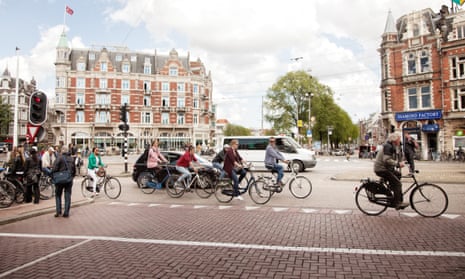
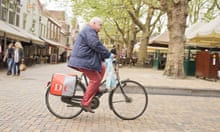


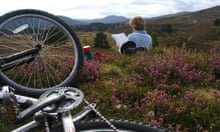
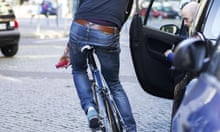

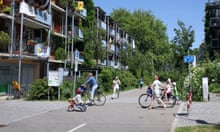

Comments (…)
Sign in or create your Guardian account to join the discussion